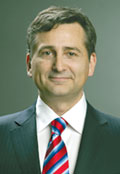
Mark Ryski is the founder and CEO of HeadCount, a leading analytics firm specializing in store traffic and conversion serving retailers across North America. For more information, visit www.headcount.com
Same-store sales are looking a little flat and you need to find ways to deliver better results. There’s still a scent of the financial melt-down lingering, but you survived and it’s time to start getting the sales needle to move in a positive direction.
One of the best ways to do this is increase your conversion rate; that is, sell to more people already visiting your stores. These are the folks who visit your store but don’t buy. Driving conversion rate is a source of sales opportunity most retailers today overlook.
Before you can drive conversion, you need to actually track prospect traffic. This is not the same as transaction counts. Transaction counts represent the number of people who made a purchase; traffic counts represent the total number of people who came to the store including buyers and non-buyers.
If you don’t track traffic in your stores, you can’t calculate conversion rate. If you can’t calculate conversion rate, well, you can’t improve it. So for the roughly 35 percent of businesses who actually track traffic and conversion rates, here are five ways you can improve conversion rates in your stores.
Understand why people don’t buy:
One of the most important things a retailer can do to improve conversion rates is to understand why people don’t buy. Long till line ups, can’t find sales help, out-of-stocks, poor merchandising, the list goes on. Every store manager should spend some time observing visitors in his/her store. Resist the temptation to help; just observe the behaviours. Watch customers as they move through your store and it won’t take long for you to identify some actions you can take to turn more visitors into buyers.
Align your staff to traffic not transactions:
Sounds simple enough, but it is something many retailers overlook. Staff scheduling is tricky at the best of times, but aligning your staff resources to when prospects are in your store will help you maximise your chances of converting more of them into buyers.
Look for conversion leaks and plug the holes:
Traffic volume and conversion rates tend to be inversely related. That is, when traffic is high, conversion tends to sag. When traffic levels are low, conversion rates tend to go up. It’s not hard to understand why this happens. When the store is busy, till lines are longer and it’s harder to get help from an associate. The opposite is true when the store isn’t as busy. So, if you want to improve conversion rates, look at the traffic in your store to identify when conversion rates are sagging — these sags represent the times when sales are being lost.
Set conversion targets by store:
Having goals and targets are important if you want to improve results. If you don’t have a conversion target for your store, you need to set one. It’s important to remember that every store is unique and conversion targets should be set uniquely by store. The trick is to move your own conversion rate up relative to your store’s performance.
Make conversion a team sport:
It takes the collective effort of all staff to help turn prospects into buyers. From the cashiers and sales associates to the merchandisers — everyone in the store plays a role. Don’t think of conversion as merely some business metric, but rather a simple measure of how well the whole store is doing at helping people buy.

